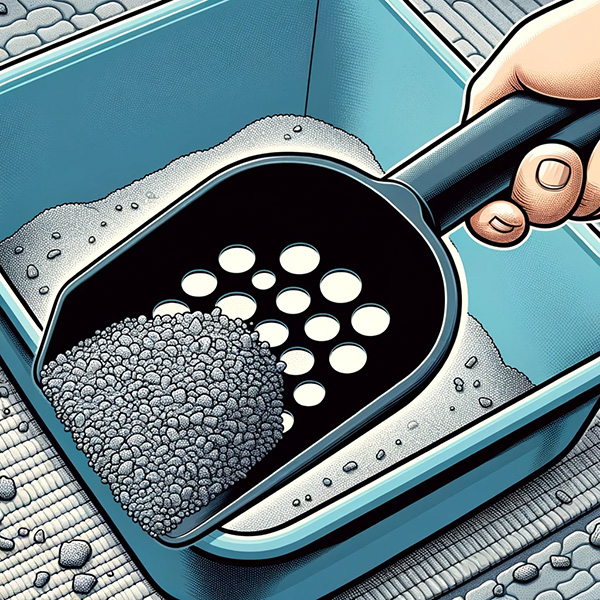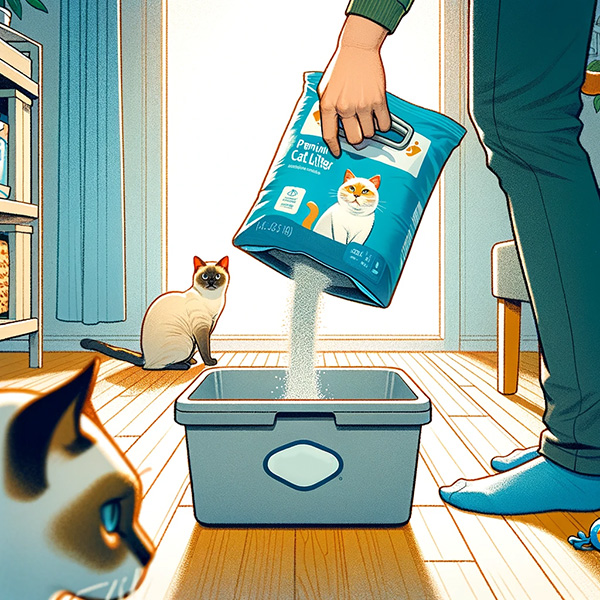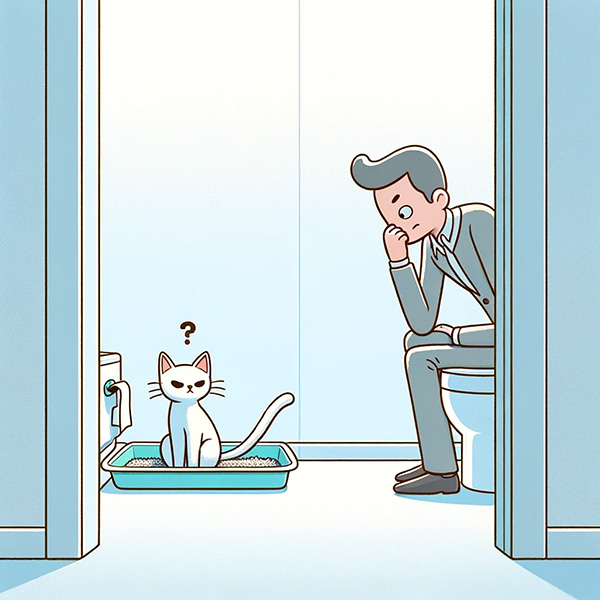As a cat parent, one of your most pressing concerns is maintaining a clean and healthy environment for your furry friend. The litter box is a vital component in your cat's daily routine, with the selection of litter impacting the well-being of both you and your feline companion. Clumping litter has become a popular choice for many due to its ease of use and efficiency in odor control. However, with convenience comes the question: How often should you change the clumping litter box to ensure optimal cleanliness and hygiene?
In this guide, we dive deep into the world of clumping cat litter, unraveling the mysteries of maintenance, and offering practical advice to keep your cat's litter box fresh. Whether you're a new cat owner or looking to refine your current litter box routine, understanding the frequency and best practices for changing clumping litter is key to a happy home and a contented cat.
What is Clumping Litter

Clumping cat litter is a type of cat litter designed to make pet waste management both easier and more efficient and help keep the litter box clean. When a cat uses litter boxes filled with clumping litter, the moisture in their waste activates the litter's clumping properties, causing it to form solid, easily removable clumps. This unique characteristic is due to the main ingredient in most clumping litters: sodium bentonite, a type of clay that expands and forms tight clumps when it comes into contact with liquid.
The benefits of clumping cat litter over non-clumping varieties are significant and contribute to its popularity among cat owners. Here are a few key advantages:
Easier Waste Removal
The primary advantage of clumping kitty litter is its ease of cleaning. Because urine and feces form tight clumps, they can be scooped out without emptying the entire litter box. This makes daily maintenance less time-consuming and helps keep the litter box fresh with minimal effort.
Better Odor Control
Clumping kitty litter often contains odor-control additives that activate upon contact with moisture, helping to trap and neutralize odors more effectively than non-clumping litters. The ability to quickly remove waste clumps also prevents odors from permeating the litter box and the surrounding area.
Improved Moisture Absorption
The clumping action isolates moisture immediately upon contact, reducing the likelihood of a soggy litter box and maintaining a dryer environment for your cat. This is not only more pleasant for the cat but also helps prevent the growth of bacteria and keeps the litter boxes more sanitary.
Economical
Because clumping litter allows for selective removal of waste without frequently replacing the entire contents of the litter box, it can be more economical in the long run. You'll use less litter over time, as only the clumps are discarded, and the remaining litter stays clean and usable.
Monitoring Health
Clumping litter also serves to assist in monitoring your cat's urinary health. Changes in the urine clumps' size, frequency, or hardness can be early indicators of health issues, allowing for prompt veterinary consultation.
In contrast, non-clumping litter absorbs moisture but does not form clumps, making it necessary to change the entire cat litter more frequently to maintain cleanliness and control odors. While non-clumping cat litter can be less expensive initially and is sometimes preferred for kittens (due to concerns about ingesting clumping litter), the convenience and benefits of clumping litter make it a preferred choice for many cat owners.
How Often To Change Clumping Litter Box

Daily Maintenance
Daily maintenance of clumping litter boxes is crucial for ensuring a clean, sanitary, and odor-free environment for both your cat and your home. Clumping litter is designed to make this task both simple and efficient, but regular attention is necessary to reap its benefits fully. Here are some reasons why it's important to scoop daily:
Odor Control
One of the primary reasons for scooping waste litter daily is to control odors. Clumping litter traps odors effectively, but if clumps are left in the box, the smell can still escape, especially when the litter is disturbed by your cat. Daily removal of these clumps keeps the litter box smelling fresh.
Cleanliness and Hygiene
Cats are naturally clean animals and may be reluctant to use dirty litter boxes, potentially leading to accidents outside the box. Daily scooping ensures the box remains inviting and clean, encouraging proper litter box habits. Additionally, it reduces the risk of bacterial proliferation, fostering a healthier environment for your cat.
Litter Longevity
Regular removal of waste clumps helps the remaining litter last longer, making clumping litter an economical choice. By scooping daily, you ensure that the clean, unused litter is not unnecessarily thrown away, reducing waste and saving money.
If you have multiple cats or your cat frequents the litter box more often, you might find it necessary to increase the frequency of scooping. In multi-cat households, the litter box can become soiled more quickly, necessitating more frequent cleaning to maintain a clean and odor-free environment. Observing how quickly the litter box gets dirty and adjusting your scooping routine accordingly is essential. Some households may find scooping twice daily or even more necessary to keep up with the demand.
Bi-Weekly Changeover
The biweekly changeover of the clumping litter box is essential to maintaining a healthy and hygienic environment for your cat. This routine involves completely dumping out the old litter, cleaning the litter tray, and then filling it with fresh litter at least once every other week. Even with daily scooping to remove clumps and solid waste, some urine and odors can still seep to the bottom of the litter trays or stick to the sides, which makes a complete change in cat litter necessary.
This thorough cleaning prevents harmful bacteria buildup and maintains a fresh, odor-free environment. It also allows you to inspect the litter tray for any signs of wear or damage that could affect its usability or safety.
Regularly performing this complete changeover of fresh litter ensures that the litter tray remains a clean, safe, and welcoming place for your cat. Regular litter box maintenance is essential for ensuring your cat's comfort and health. A clean litter box prevents problems like urinary tract infections and other hygiene-related health issues. Keeping up with this biweekly cleaning schedule is a key part of responsible cat ownership, contributing to a happier, healthier pet.
Signs It's Time to Change the Litter

Recognizing the signs that it's time to change the litter in your cat's litter box is crucial for maintaining a clean, comfortable, and healthy environment for your feline friend. Here are some key indicators that it's time to replace the litter:
Avoidance of the Box: If your cat starts avoiding their litter box or suddenly prefers doing their business elsewhere, it's a strong indication that the litter box is not up to their standards. Cats are inherently clean animals, and a neglected litter box can result in litter box aversion.
Strong Litter Box Smell: One clear indicator that it's time to change the litter is the presence of strong, unpleasant odors. Even if you scoop regularly, odors can accumulate over time, indicating that a complete litter change is necessary.
Visible Clumps and Waste: While daily scooping removes most clumps and waste, over time, some may be missed or broken apart, leading to an accumulation. If you start noticing visible clumps or waste that cannot be easily scooped, it's time for a fresh start with new litter.
Wet Litter at the Bottom: Sometimes, despite the clumping action, urine can seep into the bottom of the litter box and create a wet, sticky layer. If you notice wet litter that sticks to the scoop or the bottom of the box, it clearly shows that the litter needs to be changed.
Litter Box is Too Full or Too Empty: Proper litter maintenance also involves monitoring the litter level. If it's too full, it can lead to waste spillage outside the box. It won't effectively absorb odors and moisture if it's too empty. Adjusting the litter to the correct level may require a complete change if the current litter is no longer usable.
Change in Texture or Color: Over time, the texture and color of the litter can change due to the accumulation of waste and cleaning chemicals. If the litter appears discolored or the texture becomes unappealing and damp, it's time to change.
